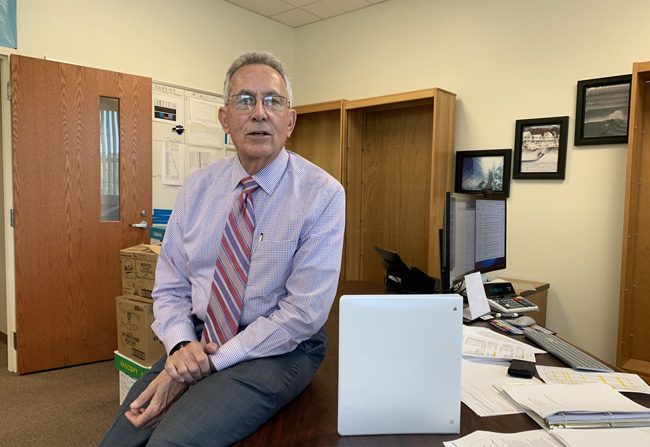
To learn how much additional money per student the Flagler County school district is getting for the 2019-20 school year, you could rely on what legislators claim in post-session chest-thumping: that they’ve approved a $242 increase. For Flagler County, that translates to an increase of $2.8 million in a projected $95.6 million K-12 budget. Or you could sit down with Tom Tant, Flagler schools’ finance director, who’ll walk you through the way that $2.8 million actually breaks down, shorn of legislative spin.
The $2.8 million figure starts out as an appropriation. It soon becomes an allegation. Then an outright lie.
In fact, the Flagler County school district is operating on the assumption that it won’t have a $2.8 million increase, but a a $1.3 million to $1.5 million deficit. It will have to close that deficit before approving next year’s budget. How does that happen? Pull up a chair by Tant’s desk and hear him explain the line-item fine print of state-funding deceptions, slippery definitions and unfunded mandates.
Start with the Best and Brightest state grant. The Legislature established that grant three years ago as a bonus program for better-performing faculty. It’s been in the budget for the past three years, as a grant. It was worth $1.2 million to Flagler this year. It’s set to get $1.3 million next year. Except that now, the Legislature shifted the amount out of the state grant and moved it into the district’s regular funding formula–and called it a funding increase because, strictly speaking, the funding formula is seeing a bump.
“That’s $1.3 million of their increase,” Tant says. “They’re saying they’ve increased it. It doesn’t increase one dollar to the school district, because we’ve got it already. That’s the big difference this year. They’ve taken something that used to be a state grant, they’ve moved it into the FEFP calculation, and they claimed they’ve increased funding to the school district. Cash-wise, no.” (FEFP is the acronym for the Florida Education Finance Program, the state’s school funding formula.)
So that alleged net funding increase accounts for $1,267,558. Since the district this year had received $1,180,055 for its Best and Brightest grant, it is realizing an increase in that category of about $85,000, but that’s it. “That’s the big deal,” Tant says. That reduces the actual state-funding increase to roughly $1.5 million.
But not really.
There’s the McKay scholarship program. The Legislature established the McKay scholarship in 1999 as a private-school voucher program for students with disabilities. McKay schools don’t have to be state accredited. They don’t have to abide by state education or other standards. They are rarely inspected. McKay money is channeled through the school district within which McKay schools are located. But the district doesn’t see the money. It’s public dollars paying for private education. “We never get it,” Tant said. Seventy-one students in Flagler qualify for McKay scholarship dollars. “It’s fake revenue.”
Yet the McKay scholarship money is included in Flagler’s funding formula. “We’ll never get the money. That’s $482,600,” Tant says. So take out the $482,000. That reduces the supposed funding increase to just over $1 million.
But not really.
“That increase is taken up by categoricals that increased,” Tant says. For instance, “safe schools,” the state allocation for security that pays for school cops and school “hardening” and other such measures, went up $71,000. That money can’t be used for any other purpose. The mental health allocation went up $26,000. That can only be spent on mental health programs. Nothing discretionary. That chips away at the funding increase, though
“You end up with a $965,000 increase–on a hundred million dollar business. That’s how much more money we get next year,” he says,
But not really.
That increase is based on the assumption that 71 new students will enroll, in a net increase from previous year enrollment. If 71 students do enroll, it’ll cost the district an additional $500,000 in faculty, service employees and other costs. That comes out of the $965,000 increase. And if the students don’t show up, which is a real possibility in a district that hasn’t seen a net increase in enrollment in 12 years, the state will take back $500,000. Either way, it’s not net new money. It’s not discretionary. It’s committed to one of two pots. That reduces the district’s actual new, discretionary money to $465,000.
But not really.
The Florida Retirement System, employees’ pension program, which requires the district to contribute to each employees’ account on top of what the employee contributes, raised the rate this year. That’ll cost an extra $100,000. The district’s health insurance premiums’ contribution is going up $360,000. The district’s risk management–hurricane insurance, property insurance and so on–is going up $69,000. Those inescapable cost increases add up to $529,000. Which nets the district, in new money, negative $64,000.
Now the district is in the red. And built-in costs are not over with.
The district’s contractual salary increase for the 2019-20 school year by itself is worth $1.5 million (for faculty and service employees). It could be more, depending on ongoing negotiations between the district and its service employees. That means the district has a $1.5 million budget gap to fill.
And that’s how you turn a $2.8 million surplus into a deficit.
Even that’s not what rankles Tant the most, because it doesn’t have to be that way. “This is the real news,” he says, taking out a chart, “and this is what people ought to know.”
Not every county gets the same per-student allocations. Flagler gets $7,402 per student. It’s near the bottom of the chart. Volusia gets a bit more. Putnam gets $7,764 per student. Palm Beach gets $8,000. Sixteen other counties get between $8,000 and $9,000. Two counties are closer to $10,000.
The state doles out money after accounting for supposed cost-of living adjustments. Flagler gets less because based on the state’s nearly intractable formula, local “amenities” such as beach living and a presumed lower cost of living reduce the state’s allocation. And in that regard, Flagler ranks 62nd out of 67 counties in per-student funding–even though its required “local effort” in property tax revenue sent to the state ranks 12th.
Few other counties come close to such a disparity. Monroe, Jefferson and Collier counties all get between $9,000 and $10,000 per student. Monroe’s and Collier’s required local effort is lower than Flagler’s, Jefferson’s is barely higher. The state produces another chart that showed how districts ranked in total state education funding as of May 1, and what county had the largest shortfall from the state average. It’s Flagler, at $3.1 million below the state average.
That’s what gets Tant going most.
“We’re the 12th highest required local effort taxes in the state. And we get the least. When you look at our surrounding districts, like Volusia and St. Johns, you’ll see that,” Tant says, chart in hand. “Volusia is right here above us. But look where they are on the taxes, 58th. See, it makes sense. This is unique in the whole state. No other district is spending the most in taxes and getting the least. None. We are over $3 million under the average funding for districts. This is the news. This is what’s wrong. And it’s still wrong. That’s the news. And nobody can defend it. You know what they say? ‘It’s the formula. It’s the formula.’ But hey, does that help our taxpayers who are paying higher tax rate than Palm Beach, and getting the least amount of money per student for our students in our county.”

The numbers will be re-evaluated on July 18. That’s the calculation that’ll be the basis of the district’s public hearings before next year’s tax rates are set. But the numbers aren’t expected to change much. ‘The formula the legislature uses is penalizing Flagler County students and our taxpayers, period. It is indefensible.”
Tant says he’s been in the ears of Flagler lawmakers Paul Renner and Travis Hutson for three years to change the formula. Nothing has happened so far.
“We’ve been in a situation now for what, four years, where we’re getting this lack of funding. It’s unsustainable to maintain the district’s compensation schedules with the funding we’re currently getting.”
That makes the discussion about an increase in the local property tax for schools, in the range of 50 cents per $1,000 in assessed value (what’s commonly referred to as a 0.5 mill increase, necessary. (See an explanation of mills and millage here.)
In 2013 the district tried to get that 0.5 mills and lost, with 57 percent of voters opposed, in part because the referendum was scheduled as a special election, drawing on the minimal turnout of such elections, in part because the referendum was tied to adding school cops in all elementary schools (it was soon after the Newtown school massacre) but also restoring 45 minutes to the school day, and in part because the era of bogus claims about the district’s finances was already claiming vast swaths of social media attention.
The Great Recession had led to a reduction of 43 teaching positions, the elimination of 45 minutes a day of schooling, the closing of a $1.2 million alternative school (what used to be known as Pathways), the closing of Phoenix, a school within a school that would have been considered a flagship program today, and teachers’ planning period was to the beginning of the school day, forcing them to teach six consecutive classes a day, because the district couldn’t afford placing the planning period within the school day, as other districts do.
The district never restored those cuts. And it’s still seeing itself in a position of deficits. That’s why it’s beginning to discuss a 0.5 mill tax increase, possibly for a 2020 or 2021 referendum, as the school board did at a retreat last month.
“We have to go there,” Tant said. “That means is our tax payers have to take control of their taxes, because that extra 0.5 or 1.0 mil stays in the district. The Legislature can’t touch it. And guess where the money’s spent? Right here.” He added: “It is the only way we’re going to survive if we don’t start getting students.”
Even then, the district’s finances won;t be back where they were before the Great Recession. The district’s budget 12 years ago was $91.2 million. In inflation adjusted dollars, that’s the equivalent of $115 million today. But the district is getting only $95.6 million in current dollars, a nearly $10 million deficit from where it ought to be, just to keep up with inflation.
“It is glaring,” Tant says. “It’s unsustainable.” At least not if the district intends to remain competitive, let alone meaningfully climb the charts of performance achievements.




























Merrill S Shapiro says
Florida Constitution, Article IX: Education. SECTION 1. Public education.–The education of children is a fundamental value of the people of the State of Florida. It is, therefore, a paramount duty of the state to make adequate provision for the education of all children residing within its borders. Adequate provision shall be made by law for a uniform, efficient, safe, secure, and high quality system of free public schools that allows students to obtain a high quality education
Dump Renner. Dump Hutson! Replace them with those who take our laws seriously!
Carolyn Kittrell says
Well l think our problem is to much property being bought instead of putting it where it’s needed.
Born and Raised Here says
Do I see an AUDIT coming.
snapperhead says
All you need to know about GOP support for quality education is here: https://wallethub.com/edu/most-educated-states/31075/ Look at the lowest ranked states….most are solid “red” states.
joseph pulitzer says
Keep voting in Republicans see what your get!